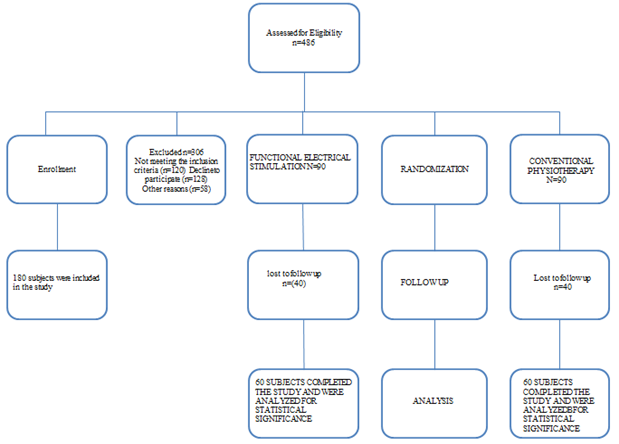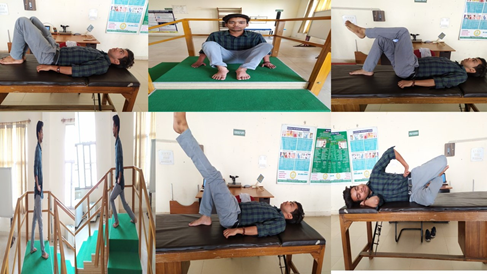Effect of Functional Electrical Stimulation on Erectile Dysfunction in Post –Stroke Survivors- A Randomized Cinical Control Trail
Article Information
Gowrishankar Potturi1*, Krishna Reddy Vajrala2, Anjali Agarwal1
1Department of Physiotherapy, Faculty of Paramedical Sciences, Uttar Pradesh University of Medical Sciences, U.P, India
2Physiotherapist, Jjt University, Jhunjhunu, Lalita Superspeciality Hospitals, A.P, India
*Corresponding author: Gowrishankar Potturi, Department of Physiotherapy, Faculty of Paramedical Sciences, Uttar Pradesh University of Medical Sciences, Saifai, Etawah, U.P, India
Received: 03 February 2020; Accepted: 10 February 2020; Published: 25 February 2020
Citation: Gowrishankar Potturi, Krishna Reddy Vajrala, Anjali Agarwal. Effect of Functional Electrical Stimulation on Erectile Dysfunction in Post –Stroke Survivors- A Randomized Cinical Control Trail. Archives of Physiotherapy and Rehabilitation 3 (2020): 009-017.
View / Download Pdf Share at FacebookAbstract
Background: Stroke often affect sexual health in a negative way. The common sexual dysfunction amongst stroke survivors are decreased libido, impaired erectile and ejaculatory functions, decreased vaginal lubrications, impaired ego, self-esteem, and depression.
Objective: To find the effectiveness of Functional electrical stimulation on improving erectile function in Post-stroke patients.
Methods: It is a single - blinded randomized controlled trail, 486 hemiplegic patients from a 1st stroke admitted into the Hospital were screened for the study of whom 180 patients full filled the inclusion criteria and were randomly divided into two groups. 120 patients completed the study. Functional electrical stimulation group was given functional electrical stimulation, for a period of 4 weeks with 4 sessions per week with 15 min each session. After the intervention, the patients were trained for pelvic floor and home exercises. Conventional Physiotherapy group was given pelvic floor and home exercises. The erectile dysfunction was measured by International Index of Erectile Function and erectile function was measured by erectile hardness.
Results: The mean of differences between Preintervention and postintervention IIEF in FES group is 8.85 SD +/-3.16 and that of Conventional Physio. group is 5.13 SD +/- 3.92. With‘t’ value 4.53, the test is significant at p<0.05, which indicates the results are statistically significant. The mean of differences between Preintervention and postintervention EHS in FES group is 1.63 SD +/-1.28 and that of Conventional Physio. group is 0.77 SD +/- 0.87. With‘t’ value 4.34, the test is significant at p<0.05, which indicates the results are statistically significant. The magnitude of the experiment effect revealed large effect (Cohen’s d >0.7).
Conclusion: We conc
Keywords
Erectile Dysfunction, Physiotherapy, Stroke, Rehabilitation, FES, IIEF, EHS
Erectile Dysfunction articles, Physiotherapy articles, Stroke articles, Rehabilitation articles, FES articles, IIEF articles, EHS articles
Article Details
1. Introduction
Stroke is a medical emergency characterized by the WHO as “rapidly developed clinical signs of focal (or global) disturbance of cerebral function, lasting more than 24 hours or leading to death, with no clear cause other than of vascular origin”. Stroke is the 3rd leading cause of death and one of the major causes of long-term disability. Sexual dysfunction is a disability arising post-stroke which is not often addressed and greatly influences the quality of living among stroke survivors as well as their partners in a negative way [1]. Stroke often leads to decrease in physical ability that might affect sexual health in a negative way [2]. Sexuality ease is one of the most complex aspects of human life with myriad physiological and psychological influence [3-5], The common sexual dysfunction amongst stroke survivors often observed is decreased libido, impaired erectile and ejaculatory functions decreased vaginal lubrication, impaired ego, self-esteem, and depression [6]. The sexuality in stroke patients is affected by the motor, sensory, cognitive and physiological factors that are resulting from stroke and affect the desire and ability to engage in sexual activities in many ways [7]. Male sexual dysfunction is defined as a physical or psychological condition preventing a man from achieving sexual satisfaction and encompasses erectile dysfunction (ED), premature ejaculation, loss of libido, and hypogonadism [8]. The process of sexual activity for men, including male sexual arousal, penis erection, penis inserting into vagina, ejaculation, is called sexual dysfunction [9]. Sexual dysfunction is a change in a phase of the sexual activity that can result in frustration, pain, leading to reduction in the number of sexual intercourses [10].
1.1 Objective of the study
To find the effectiveness of Functional electrical stimulation on improving erectile function in Post-stroke patients.
2. Materials and Methods
The study was conducted at Lalita Super specialty Hospitals, Guntur, Andhra Pradesh, India during 2016-17 for a period of 1 year. It is a single - blinded randomized clinical controlled trail, (the subjects of the study are blinded). A total of 486 hemiplegic patients from a 1st stroke admitted into the Hospital were screened for the study of whom 180 patients full filled the inclusion criteria and agreed to join the study as subjects. They were randomly divided into two groups Functional electrical stimulation group (FES) experimental and Conventional physiotherapy group (CP) control group. At follow up 120 patients completed the study and were analyzed for statistical significance. Patients had to satisfy the following inclusion criteria for this study
- Confirmed diagnosis of stroke by CT / MRI scan.
- Mentally cognitive and ability to communicate
- Interested to participate in the study and cooperative
- Males were included.
- A minimum of FIM (Functional Independence Measure) scores 4 or more.
- Sexually active persons before the incidence of stroke.
- Age between 20-70 years.
Patients were excluded if they had any one of the following criteria
- Severe cognitive issues
- Dementia
- Aphasia
- Associated cardiac problems which demand cardiac pacemaker
- Psychologically unfit
- Uncooperative patients
- Patients with less than 4 FIM (Functional Independence Measure) scores.
- Sexually inactive persons before the stroke.
The patients were explained about the study and took prior consent before enrolling them into the study. The patients are randomly assigned into two groups after satisfying the inclusion criteria, Functional Electrical Stimulation Group (Experimental) (n=60) and Conventional Physiotherapy group (control) (n=60). (Figure 1)
2.1 Intervention
FES group (Experimental) was given functional electrical stimulation, for a period of 4 weeks with 4 sessions per week with 15 min each session. Interrupted Galvanic stimulation with a 50 Hz frequency and 500µs, with intensity set below the motor threshold level. Two self-adhesive electrodes measuring 3 cms each were used. The pubic area was shaved and cleaned with soap water to decrease the skin resistance and dried. One electrode is placed at the base of the penis and second was placed 2 cms below the first one. After the intervention, the patients were trained for pelvic floor muscles strengthening exercises and home exercises. Conventional Physio. Group (Control) was given pelvic floor muscle strengthening exercises and home exercises for 4 weeks with 4 sessions per week with 30 min each session. (Figure 2)
2.2 Outcome measures
The erectile dysfunction was measured by International Index of Erectile Function (IIEF). The Domain A of this score was taken which measures the erectile function of patients. Domain A has 6 questions, with scoring from 0-5 for each question, thus making a total score 30. A score less than 14 is considered as having erectile dysfunction. The more the score the better is the Erectile function in Patients. The erectile function was also measured by Erection Hardness score (EHS) which is a single-item Likert Scale which measures the rate of hardness of erection in males. The scores are between 0-5, where 0 represents penis does not enlarge and 4 is penis is completely hard and fully rigid.
2.3 Statistical analysis
In this study to analyze the role of Functional electrical stimulation on erectile dysfunction in stroke patients, The pre - training outcome variables of age, time since onset of stroke, Diagnosis (Ischemic or Hemorrhagic), side of hemiplegia were compared using Mann Whitney U test. ( Table-1). All Pre intervention and post intervention scores of IIEF and EHS were expressed as Mean +/- Standard deviation (SD) and was statistically analyzed using paired t test within the groups and unpaired t-test to determine statistical difference among the groups at 5 % level of significance. To explore the practical significance of group differences, the effect size was calculated. The established criteria of the ES, which reflects the effect of treatment within a population of interest, are small (<0.41), medium (0.41 to 0.7), or large (> 0.70) [15].
3. Results
There was no clinically relevant difference for age, Diagnosis, Side of Hemiplegia, Time since the onset of stroke which was analyzed by Mann Whitney U test. (Table 1).
The Preintervention IIEF mean of FES group is 12.35 SD +/- 2.37 and postintervention mean is 21.2 SD +/- 4.91. The Preintervention mean of IIEF of Conventional Physio. Group is 12.7 SD +/- 3.16 and postintervention mean is 17.8 +/- 3.25. The mean of differences between Preintervention and postintervention IIEF in FES group is 8.85 SD +/-3.16 and that of Conventional Physio. Group is 5.13 SD +/- 3.92. With‘t’ value 4.53, the test is significant at p<0.05, which indicates the results are statistically significant. . The Preintervention EHS mean of FES group is 2.08 SD +/- 1.12 and postintervention mean is 3.8 SD +/- 0.61. The Preintervention mean of EHS of Conventional Physio. Group is 2 SD +/- 1.07 and postintervention mean is 2.77 +/- 0.62. The mean of differences between Preintervention and postintervention EHS in FES group is 1.63 SD +/-1.28 and that of Conventional Physio. Group is 0.77 SD +/- 0.87. With‘t’ value 4.34, the test is significant at p<0.05, which indicates the results are statistically significant. (Table 2). By examining the above statistical analyses we reject the null hypothesis as Gr A showed a significant increase in IIEF scores and EHS scores than Conventional Physio. Group. The magnitude of experiment effect is calculated by measuring effect size by Cohen’s d and revealed large effect size. (Table 3)
|
S.no |
Characteristic |
FES Group |
Conventional Physio.Group |
P value |
|
1 |
Age (years) * |
40.2 |
42.1 |
P > 0.05 |
|
3 |
Etiology (ischemic/hemorrhagic) |
43/17 |
44/16 |
|
|
4 |
Side of hemiplegia (right/left) |
18/42 |
22/38 |
|
|
5 |
Time post stroke before recruitment* (in Months) |
3. 3.13+/-1.77 |
3.01+/1.39 |
*Mean & SD; The variables were analyzed using Man-Whitney “U” test
Table 1: Demographic Data of FES group and Conventional Physiotherapy Group.
The variables are tested for statistical significance by paired ‘t’ and independent ‘t’ test.
Table 2: Pre-intervention and Post-intervention EHS & IEF scores in FES group and Conventional Physiotherapy Group.
|
S.NO |
Variable |
Cohen’s d |
Effect size |
|
1 |
EHS |
1.044 |
LARGE |
|
2 |
IIEF |
0.785 |
LARGE |
Table 3: Effect size calculation.
4. Discussion
In this study the Role of Functional electrical stimulation on treating erectile dysfunction in post stoke patients, the study has shown that Functional electrical stimulation has shown to be effective in treating erectile dysfunction, in post-stroke patients. The FES group (experimental) has shown greater improvements in the IIEF and EHS scores when compared to the Conventional Physio. Group (control). The IIEF scores range from 5-25. A score of 21 or lower is considered as having sexual dysfunction. The severity of erectile dysfunction is classified into 5 categories based on severity, absence of ED (IIEF-5 score 22-25, mild to moderate (12-16), moderate (8-11) and severe (5-7) [18]. In our study, the FES group, the severity of ED has changed from moderate to absence of ED, while the conventional physio group from moderate to mild ED. Sexual dysfunction is which is a common disability in stroke survivors and is influenced by multifactorial causes leading to decrease in sexual desires, interest and coital frequency in both sexes, a decline in vaginal lubrication and orgasm in females and in erection and ejaculation in males. The motor dysfunction and lacunae in communication are two major causes that often lead to sexual dysfunction in stroke survivors. The inability to satisfactorily develop or maintain an erection of the penis during sexual intercourse is often termed as erectile dysfunction [11]. The erection is penis is obtained by pro-erectile autonomic pathways and depend upon the adequate inflow of blood to the erectile tissue of penis [12]. The spinal autonomic centers control the penile erection and receives input from the supraspinal centers and genital. The culmination of multiple nerve reflexes can initiate a vascular event [13]. Many studies have shown that erectile dysfunction occurs mainly by degeneration of cavernous smooth –muscle degeneration. The smooth muscle regeneration can be promoted by Functional electrical stimulation and is considered as a safe tool for the treatment of erectile dysfunction [14]. The FES stimulates the smooth muscle cells of the cavernous body of penis and enhances the responsiveness and reaction speed in the smooth muscle. There are very few researches on functional electrical stimulation for erectile dysfunction. In the study by Cristiane et al. [17] an initial study on the effect of functional electrical stimulation in erectile dysfunction, they concluded that FES therapy may improve erectile function and quality of life in men with erectile dysfunction [15].
5. Conclusion
We conclude from this study that Functional electrical stimulation improves erectile function in stroke survivors and is a treatment of choice for erectile dysfunction in post-stroke patients.
Ethical Approval:
All procedures performed in studies involving human participants were in accordance with the ethical standards of the Lalita superspecialities Hospital Ethics committee Ref.no:ECR/439/Inst/AP/2013/RR-16 and with the 1964 Helsinki declaration and its later amendments or comparable ethical standards.
Acknowledgements
We would like to express our gratitude to the management of Lalitha Super specialty Hospitals, Guntur who permitted to conduct the study and special thanks to the staff members of the hospital, for their guidance and timely help throughout the project. We would also like to thank all the subjects who participated in this study, without them this project would not have been successful.
Declaration
We, all the authors here with certify that the article is approved for the final version of the manuscript being submitted. We warrant that the article is the author’s original work, hasn’t received prior publication and isn’t under consideration for publication elsewhere.
Conflicts of Interest
The authors declare no conflicts of Interest.
Funding
The study was not funded by any organization.
References
- Kautz D D, Van Horn E R. Sex and Intimacy after Stroke. Rehabilitation Nursing 42 (2016): 333-340.
- Thompson H, Ryan A. The impact of stroke consequences on spousal relationships from the perspective of the person with stroke. Journal of clinical nursing 18 (2009): 1803-1811.
- Mezzich JE, Hernandez-Serrano R. In: Psychiatry and Sexual Health – An Integrated Approach. Lanham: Jason Aronson. Comprehensive definition of sexual health (2006): 3-13.
- Green T, King K. Functional and psychosocial outcomes 1 year after mildstroke. Journal of stroke and cerebrovascular diseases 19 (2010): 10-16.
- Tamam Y, Tamam L, Akil E, et al. Post-stroke sexual functioning in first stroke patients. European journal of neurology 15 (2008): 660-666.
- Monga TN, Lawson JS, Inglis J. Sexual dysfunction in stroke patients. Arch Phys Med Rehabili 67 (1986): 19-22.
- Rosenbaum T, Vadas D, Kalichman L. Sexual function in post stroke patients: considerations for rehabilitation. J Sex Med 11 (2014): 15-21.
- Laumann EO, Paik A, Rosen RC. Sexual dysfunction in the United States: prevalence and predictors. JAMA 281 (1999): 537-544.
- Malviya N, Malviya S, Jain S, et al. A review of the potential of medicinal plants in the management and treatment of male sexual dysfunction, Andrologia 48 (2016): 880-893.
- Clayton A, Ramamurthy S. The impact of physical illnesses on sexual dysfunction. Adv Psychosom Med 29 (2008): 70-88.
- Korenman S G. Clinical review 71: Advances in the understanding and management of erectile dysfunction. J. Clin. Endocrinol. Metab 80 (1995): 1985-1988.
- Temeltas G, Dagci T, Evren V, et al. Effects of Neuronal and Glial Restricted Precursor Cells Transplantation on Erectile Function after Experimentally Induced Spinal Cord Injury. The Journal of Sexual Medicine 6 (2009): 3265-3273.
- Dean R, Lue TF. Physiology of penile erection and pathophysiology of erectile dysfunction. Urol Clin North Am 32 (2005): 379-395.
- Jiang J, He Y, Jiang R. Ultrastructural changes of penile cavernous tissue in multiple sclerotic rats. J Sex Med 6 (2009): 2206-2214.
- Hatzimouratidis K, Amar E, Eardley I, et al. Guidelines on male sexual dysfunction: erectile dysfunction and premature ejaculation. Eur Urol 57 (2010): 804-814.
- Pournaghash-Tehrani S, Etemadi S. ED and quality of life in CABG patients: an intervention study using PRECEDE-PROCEED educational program. Int J Impot Res 26 (2014): 16-19.
- Critiane Carboni, Alexandre Fornari, Márcio Augusto Averbeck, et al. An initial study on the effect of functional electrical stimulation in erectile dysfunction: a randomized controlled trail, International Journal of Impotence Research 30 (2015).
- Rosen RC, Cappelleri JC, Smith MD, et al. Development and evaluation of an abridged, 5-item version of the International Index of Erectile Function (IIEF-5) as a diagnostic tool for erectile dysfunction. International journal of impotence research 11 (1999): 319-326.



 CiteScore: 2.9
CiteScore: 2.9  Acceptance Rate: 11.01%
Acceptance Rate: 11.01%  Time to first decision: 10.4 days
Time to first decision: 10.4 days  Time from article received to acceptance: 2-3 weeks
Time from article received to acceptance: 2-3 weeks 